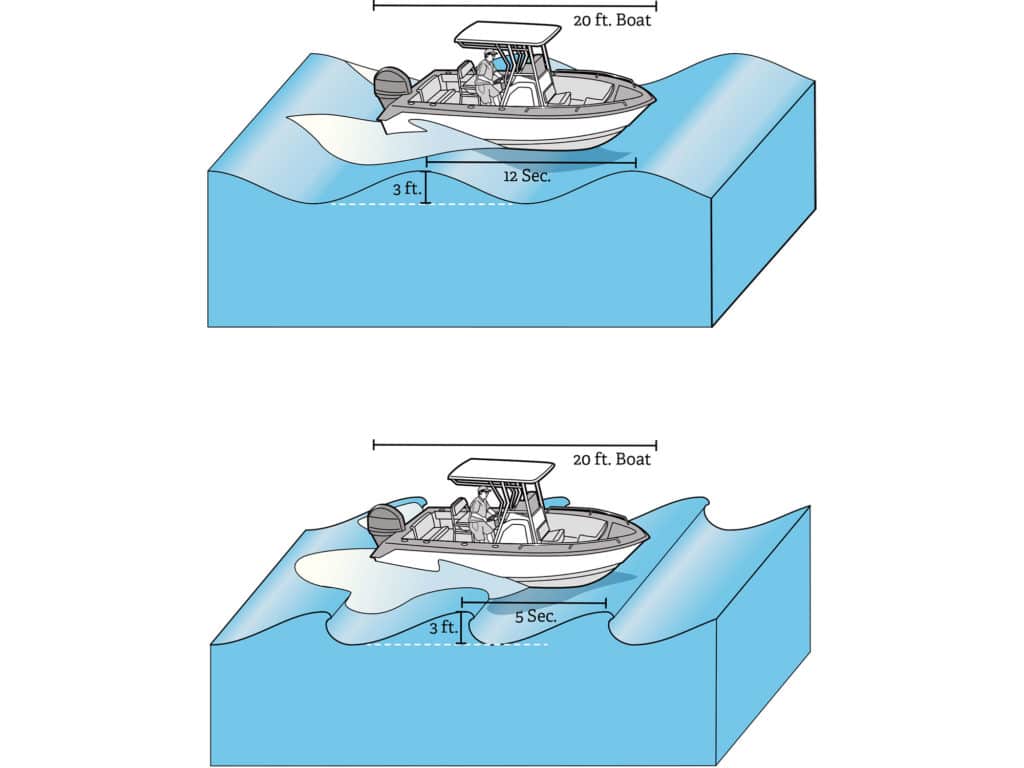
First, let me plead, “Mea culpa.” I’ll admit to fixating on marine wind forecasts before venturing out to sea, sometimes to the exclusion of wave projections.
That shortcut has more than once come back to bite me in the stern quarters.
While wind has a major effect on sea conditions, boaters need to pay attention to other elements outlined in the marine forecast and how they translate to real-life conditions at sea.
Wave Check
Planning an ocean trip without reviewing the wave forecast can lead to startling and uncomfortable surprises, as it did for me one windless morning in spring as we headed out the inlet of Mission Bay in San Diego. Had I checked the wave forecast, I would have known that a healthy lump generated by a spring gale far out in the Pacific was rolling in from the west.
As waves approached the shallows at the west-facing cut, they rose up and closed ranks like menacing demons, with steep 6- to 7-foot faces and cresting tops. Our 21-footer made it out, but the experience certainly ramped the pucker factor and required careful throttle work to climb each wave without launching and slamming hard on the back side before facing the next one and eventually escaping the danger zone.
Had I checked the wave forecast, I might have decided to launch the boat a mile down the coast in San Diego Bay, which has a much wider opening, a deeper channel and faces south, so it’s less vulnerable to a lump out of the west.
Fortunately, the waves mellowed out during the course of the day, so the return to Mission Bay was not nearly as gnarly as the exit. But the lesson here is to pay close attention to the wave forecast as well as the projected winds.
Interval Influence
Not all waves are created equal, even those of equal size. If that sounds like double talk, bear in mind that the interval between the waves has a major effect on sea conditions. For example, 3- to 4-foot waves that roll in about 12 seconds apart prove far more friendly than waves of the same height that are four to five seconds apart, as depicted in the illustration (left).
The interval also affects the shape. Three- to 4-foot waves 15 seconds apart (so-called long-period waves) tend to have gently sloping shapes. Waves of the same height that roll in four to five seconds apart tend to be much steeper, especially the faces of the waves.
With long-period waves, a boat can usually cruise smoothly at a decent clip and near-maximum efficiency.
Running into or with tightly spaced waves presents challenges. In so-called four-by-four seas (4 feet by four seconds), bigger boats might bridge the waves, but smaller boats often need to slow down and slog it out. Even with skillful boathandling, such conditions are unpleasant, hurt fuel efficiency, and can threaten safety, such as if the boat takes water across the bow or over the stern.
Negotiating tightly spaced cross seas can also prove dangerous because waves that can roll over the gunwales and shove the boat sideways lash at the boat, threatening to capsize it. These are situations that boaters want to avoid, and that’s why interpreting wave forecasts is so important.
Don’t fall into the bad habit of focusing on the wind forecast alone. Make sure you also know the projected height, interval and direction of waves relative to your anticipated course, and what that might mean for your time afloat. Based on what you learn and the size of your boat, be prepared to adjust or even postpone your plans until seas prove more favorable.
Read Next: Local Notice to Mariners
Marine Forecast Services
Here are four of the marine weather apps I use on my mobile phone to check wave and wind forecasts, and other weather elements affecting sea conditions before venturing out on the ocean.
- Buoy Weather (free with in-app purchases)
- NOAA Marine Weather Forecast ($1.99 per year)
- Windy (free with in-app purchases)
- Fish Weather (free with in-app purchases)









